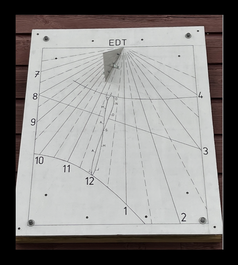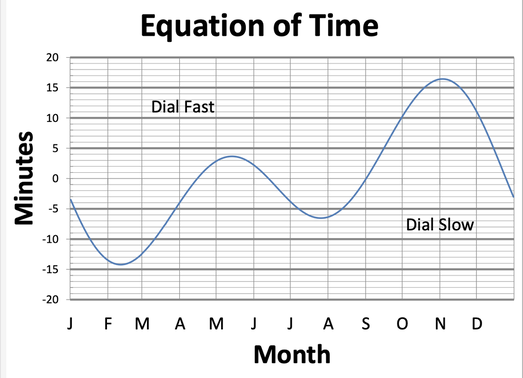No garden is really complete without a solar timepiece. Early sundials were important tools for determining planting and harvest dates, as well as providing time-of-day. The perfect blend of science and art, sundials connect us to the heavens in a quantifiable way.

The Landis dial, prominently installed on the front of the Barn, is a vertical declining dial, set to display Eastern Daylight Time (March to November). During Eastern Standard Time, subtract one hour from the dial readings. The 'Hour Lines' are diagonal lines radiating from a spot near the top of the dial. Lines corresponding to whole hours are solid, and half-hour lines are segmented (to avoid confusion). Time is read where the shadow of the top edge of the gnomon (called the 'style') falls among the hour lines.
This dial can be used to accurately set one’s watch to within a minute or two, if one knows how to read it! To do so, read the dial and apply the 'Equation of Time,’ a variable quantity that needs to be added to (or subtracted from) the dial reading to obtain 'Mean Time.' This is necessary because sundials show 'Apparent Solar Time,' while watches keep 'Mean Solar Time.' The 'Equation of Time' (EOT) is simply the difference between the two. An EOT plot is included in this article. It shows, for a given date, the correction, in minutes, to apply to the dial reading. If the EOT is negative, that means the dial will be slow relative to watch time and that the number of minutes must be ADDED to the dial reading. If the EOT is positive, SUBTRACT it from the dial reading.
In lieu of a 12:00 hour line, there is a funky figure-eight curve on the dial that contains tick marks at the first day of each month. This is an analemma. It basically makes the EOT correction for you. When the center of the tip of the gnomon's shadow is exactly on the curve (between the appropriate month marks associated with the current date), it is precisely 12:00 EDT (11:00 EST).
The two sweeping curved lines on the dial are solstice lines. On the winter solstice (ca. 12/21) the tip of the gnomon's shadow will follow the upper curve throughout the day. The shadow tip will follow the lower curve on the summer solstice (ca. June 21). The diagonal line that cuts through the middle of the dial is the equinox or 'equinoctial' line. On the equinoxes, when the Sun is in the equatorial plane, (ca. 3/20 and 9/21), the tip of the gnomon's shadow will follow that line.

Geoff Miller’s avocation is “gnomonics,” the science of sundials. A former resident of the Capital District, he now lives in New Mexico, returning to the area in the summer. He ran in the Arboretum’s 5K race several years ago and offered to construct a sundial for Landis.
